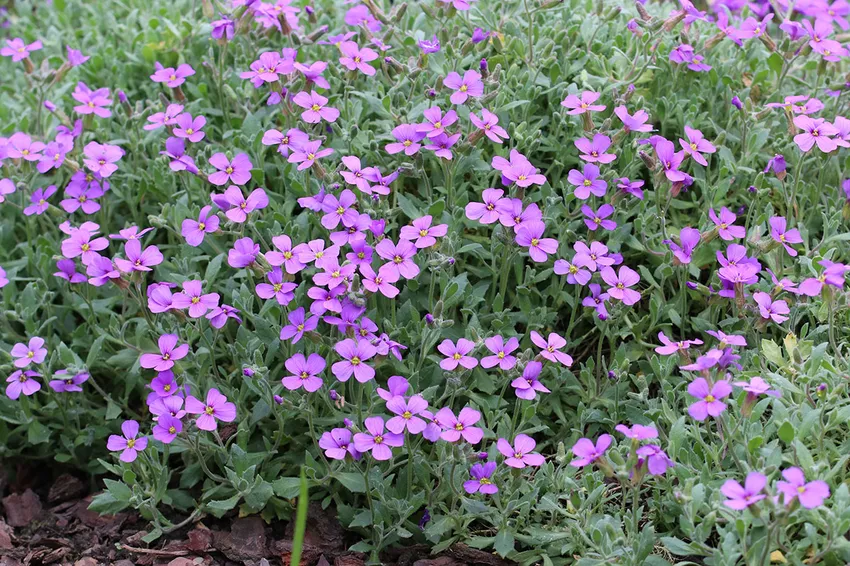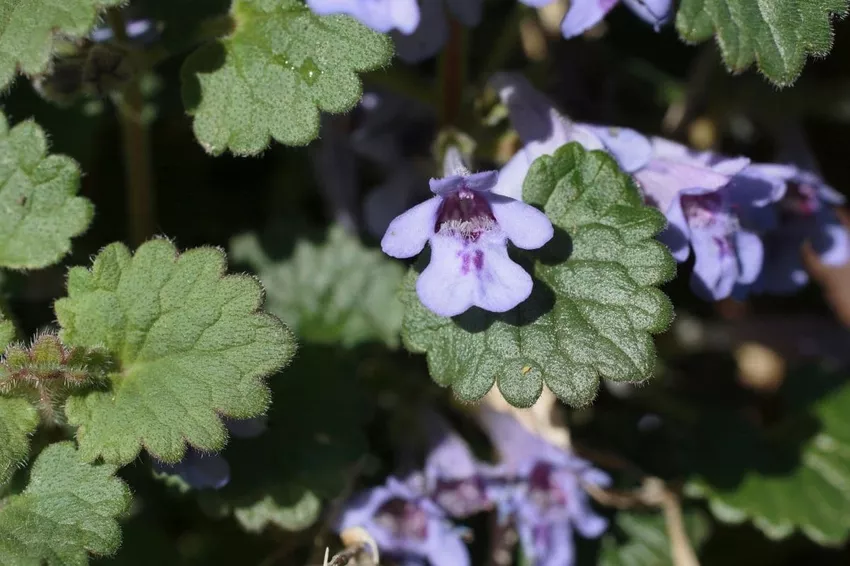- Advantages of hanging plants
- Hardy hanging plants: care
- Hardy hanging plants from A to G
- from H to J
- from K to Q
- from R to Z
- frequently asked Questions

Hardy hanging plants can be found in surprisingly large numbers. However, not all species are evergreen. We show you what can easily grow in the garden and on the balcony during the cold season.
In a nutshell
- large selection
- hardy plants are an asset to wildlife
- can be used as a privacy screen
- numerous flowering plants available
Advantages of hanging plants
The main advantage, especially of evergreen hanging plants, is their versatility. These criteria include, for example:
- biodiversity
- conditional windbreak
- decorative
- food source
- shade provider
- privacy screen
- hideout for animals
As a result, evergreen hanging plants are a kind of hedge even on a balcony. But they can also grow down from a wall or green the balcony railing.

Notice: Hardy ground covers are sometimes also suitable as hanging plants. However, since they usually grow quickly, they require more care.
Hardy hanging plants: care
Since hardy hanging plants have less substrate available due to the tub culture, the effort for care is higher than outdoors. This affects the following areas:
- Fertilize
- pour
- repot
Especially when cultivating the plants in a traffic light, they are hardly watered by the rain. However, it can happen that they are downright forgotten until the first signs of dryness or an undersupply of nutrients appear. In addition, watering is made more difficult by the height.
Therefore, it is best to immerse the planter, especially in summer, in a bucket or bucket until no more air bubbles rise. Drain afterwards to avoid waterlogging.
Hardy hanging plants from A to G
Blue Cushion (Aubrieta)
- Flower color: blue, purple, pink and red
- Flowering time: April to May
- fruits: ovate
- Watering: keep moist, avoid waterlogging
- Size: Height up to 15 centimeters
- Location: sunny
- Winter protection: not necessary in larger containers

Wire Vine (Mühlenbeckia complexa)
- Flower color: white
- Flowering period: June to July
- Fruits: white to red berries
- Watering: keep evenly moist
- Size: 20 to 30 centimeters high, shoots 50 to 100 centimeters long
- Location: sunny but no blazing midday sun
- Winter protection: absolutely necessary, hibernation can also take place in the house

Scented jasmine (Philadelphus coronarius)
- Flower color: white
- Flowering period: June to September
- Fruits: dark red berries
- Watering: always keep slightly moist
- Size: shoots up to 1.5 meters long
- Location: sunny to semi-shady
- Winter protection: insulate vessels

Ivy (Hedera helix)
- Flower color: yellow-green
- Flowering time: September to October
- Fruits: black-blue berries
- Watering: tolerates slight drought but no waterlogging, can also be watered with calcareous water
- Size: shoots up to 30 meters long, tolerates pruning
- Location: shady to semi-shady
- Winter protection: Insulate the planter

Caution: The berries are poisonous to humans. If there are children in your household or garden, you should either warn them or place the ivy out of their reach.
Ground ivy trailing plant (Glechoma hederacea Variegata)
- Flower color: pink to purple
- Flowering time: March to June
- Fruits: Klaus fruits, slightly sticky film
- Watering: keep evenly moist
- Size: shoots up to 1.5 meters long, up to 30 centimeters high
- Location: sunny to semi-shady
- Winter protection: light insulation

from H to J
Hanging cushion bellflower (Campanula poscharskyana)
- Flower color: blue to violet
- Flowering period: June to September
- Fruits: capsule fruits
- Watering: keep evenly moist
- Size: 10 to 20 centimeters high, 30 to 40 centimeters wide
- Location: sunny to semi-shady
- Winter protection: light protection recommended

Hedge myrtle (Lonicera nitida 'May Green')
- Flower color: white
- Flowering period: May to June
- Fruits: round, violet, source of food for birds
- Watering: does not tolerate waterlogging but drought, watering is therefore rarely necessary
- Size: shoots up to 1.5 meters long
- Location: sunny to shady
- Winter protection: not necessary outdoors, light winter protection in the bucket

Hop-flowered oregano oregano (Origanum rotundifolium 'Kent Beauty')
- Flower color: violet
- Flowering period: July to August
- Fruits: hop-like
- Watering: sensitive to waterlogging
- Size: about 20 centimeters
- Location: sheltered and sunny
- Winter protection: light insulation in the pot
 Source: Photo by David J. Stang, Origanum rotundifolium Kent Beauty 0zz, edited by Plantopedia, CC BY-SA 4.0
Source: Photo by David J. Stang, Origanum rotundifolium Kent Beauty 0zz, edited by Plantopedia, CC BY-SA 4.0
Evergreen scented clematis (Clematis armandii)
- Flower color: white to cream
- Flowering time: March to May
- Fruits: fluffy infructescence
- Watering: seldom but watering
- Size: shoots up to 5 meters long
- Location: sheltered from the wind and sunny, roots should be kept cool
- Winter protection: as hardy hanging plants, they still need protection or should be overwintered indoors
 Source: peganum from Small Dole, England, Clematis armandii - Flickr - peganum, edited by Plantopedia, CC BY-SA 2.0
Source: peganum from Small Dole, England, Clematis armandii - Flickr - peganum, edited by Plantopedia, CC BY-SA 2.0
Evergreen shadow sedge (Carex umbrosa)
- Flower color: red-brown spikes
- Flowering time: April to June
- Fruits: small seeds ripen on the ears
- Watering: always keep slightly moist
- Size: up to 20 centimeters high
- Location: partially shaded
- Winter protection: hardy to -25°C, therefore usually no protection required
 Source: Krzysztof Ziarnek, Kenraiz, Carex umbrosa kz02, edited by Plantopedia, CC BY-SA 4.0
Source: Krzysztof Ziarnek, Kenraiz, Carex umbrosa kz02, edited by Plantopedia, CC BY-SA 4.0
Evergreen Medlar (Cotoneaster dammeri)
- Flower color: white to slightly reddish
- Flowering period: May to June
- Fruits: red berries
- Watering: in the beginning, water the ground cover regularly and with plenty of water, later drought will also be tolerated
- Size: 10 to 15 centimeters high, shoots up to 70 centimeters long
- Location: sunny to shady, partial shade is ideal
- Winter protection: not necessary

from K to Q
Lesser periwinkle (Vinca minor)
- Flower color: blue-violet, blue, white, purple, pink
- Flowering time: first flowering April-May, second flowering throughout the summer
- Fruits: follicles
- Watering: do not allow waterlogging to occur
- Size: 10 to 30 centimeters
- Location: partially shaded to sunny
- Winter protection: outdoors, the ground cover is hardy even without protection

herb of immortality (Jiaogulan)
- Flower color: greenish white
- Flowering period: July to August
- Fruits: berries
- Watering: Avoid waterlogging and dryness, always keep moist
- Size: shoots 3 to 5 meters long
- Location: sunny to semi-shady
- Winter protection: protect the tub with plant fleece, for example

ice plant (Delosperma cooperi)
- Flower color: violet to purple
- Flowering period: June to August
- fruits: capsule fruits, spherical, brown
- Watering: small amounts, tolerate drought without any problems
- Size: up to 15 centimeters high
- Location: full sun, warm and sheltered
- Winter Protection: Overwinter with comprehensive protection

Pennywort (Lysimachia nummularia)
- Flower color: yellow
- Flowering period: May to July
- Fruits: capsule fruit
- Watering: Drying out must be avoided, high water requirement
- Size: only 5 centimeters high but shoots 25 centimeters long
- Location: sunny to shady
- Winter protection: protected from the wind, also outdoors, insulate tubs

Cushion phlox (Phlox subulata)
- Flower color: white, pink, lilac, red, multicolored
- Flowering time: April to June
- Fruits: small capsule fruits
- Watering: water frequently in tub culture and in the evening hours
- Size: up to 15 centimeters high, shoots up to 60 centimeters long
- Location: sunny
- Winter protection: very hardy, protection only required in tubs

from R to Z
Rib fern (Blechnum spicant)
- Flower: reproduces via spores, therefore no flower
- Watering: keep constantly moist
- Size: about 6 centimeters long shoots
- Location: partially shaded to shaded, sheltered from the wind
- Winter protection: leaf protection and covering of the planter

Spindle bush (Euonymus fortunei)
- Flower color: greenish white
- Flowering period: May to June
- Fruits: capsule fruits, up to 5 centimeters wide
- Watering: keep evenly moist, does not tolerate waterlogging
- Size: up to eight meters, slow growing
- Location: warm, sheltered, sunny
- Winter protection: conditionally hardy, therefore attach protection
 Creeping Spindle 'Emerald'n Gold' Euonymus fortunei 'Emerald'n Gold'
Creeping Spindle 'Emerald'n Gold' Euonymus fortunei 'Emerald'n Gold'
Rockseed (Lithodora diffusa)
- Flower color: white, blue, purple-red
- Flowering time: April to June
- Fruits: round, hard nuts
- Watering: keep slightly moist, avoid waterlogging
- Size: about 30 centimeters long shoots
- Location: sheltered from the wind, warm, sunny
- Winter protection: insulate container and cover soil

Star jasmine (Trachelospermum jasminoides 'Pink Showers')
- Flower color: pink
- Flowering period: May to June
- Fruits: oval fruit bodies with numerous seeds
- Watering: keep constantly moist, large water requirement
- Size: shoots up to ten meters long
- Location: sunny to semi-shady
- Winter protection: as an evergreen hanging plant, they can grow down to -10°C

Wild strawberry (Fragaria vesca var. vesca)
- Flower color: white
- Flowering time: April to June
- Fruits: strawberries
- Watering: Avoid drying out and waterlogging
- Size: shoots about 25 centimeters long, depending on the variety
- Location: partially shaded, no direct sun
- Winter protection: as hardy hanging plants, they do not need any protection when planted outdoors, the planter must be insulated in the bucket

Black-green privet 'Atrovirens' (Ligustrum vulgare Atrovirens)
- Flower color: creamy white
- Flowering period: June to July
- Fruits: dark purple berries
- Watering: Water when dry, avoid waterlogging
- Size: up to four meters
- Location: sunny to shady
- Winter protection: necessary in the planter, not necessary outdoors

frequently asked Questions
Are hardy hanging plants evergreen?No, just because a plant can withstand frost doesn't mean it's evergreen. Deciduous variants are even found in the majority.
Why Are Evergreen Hanging Plants So Handy?Because they fulfill several purposes at the same time: For example, to offer insects and birds a hiding place and a source of food.
Is a traffic light absolutely necessary?No, pots, tubs and boxes can also be used. Among other things, this allows the balcony railing to be greened or a privacy screen to be created.